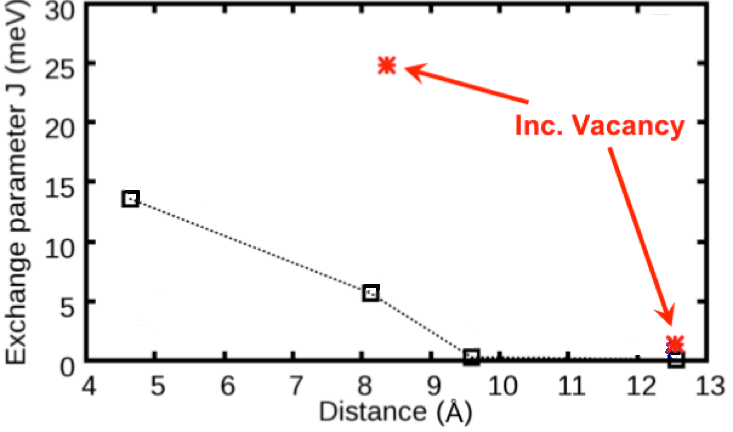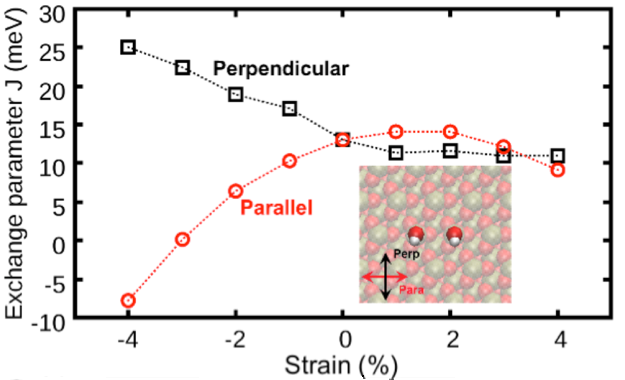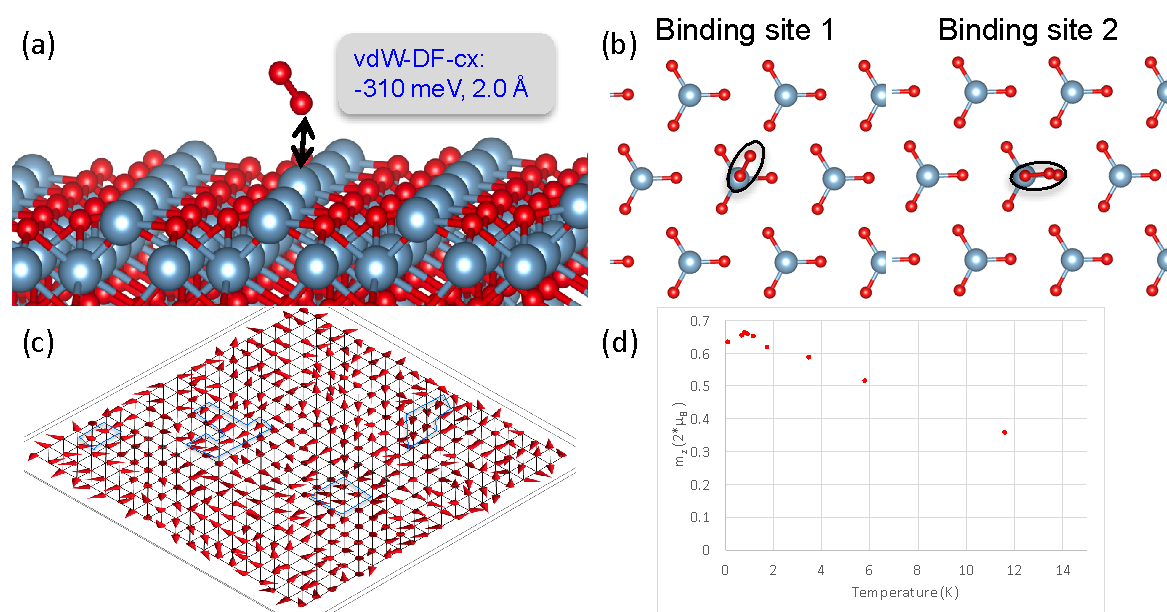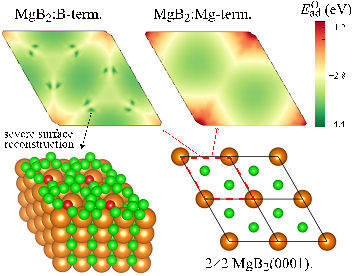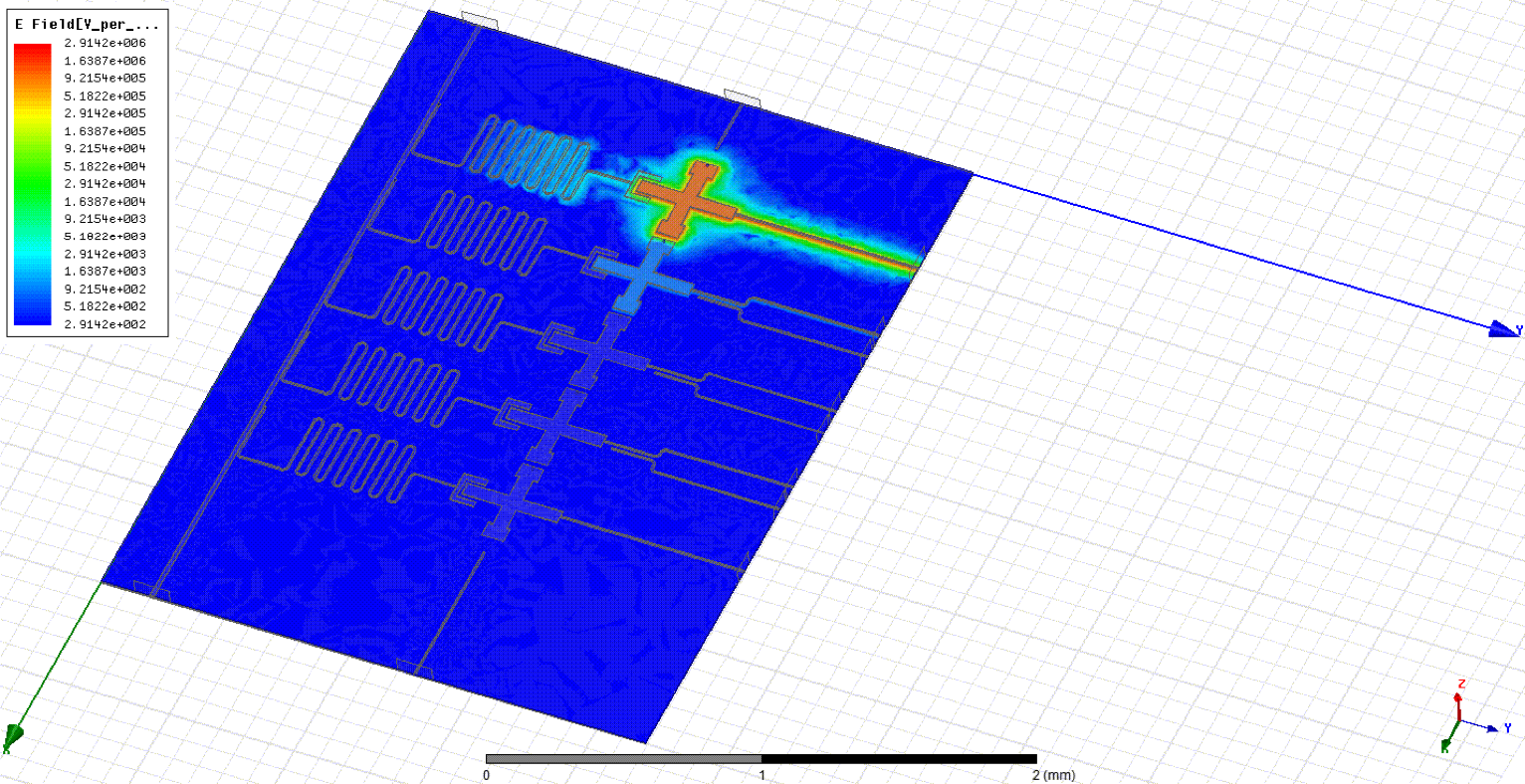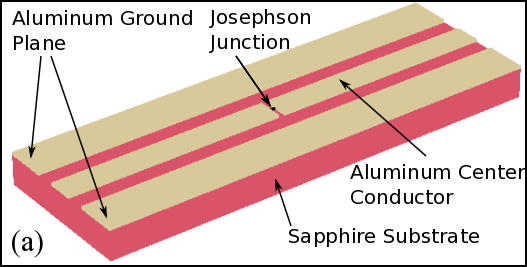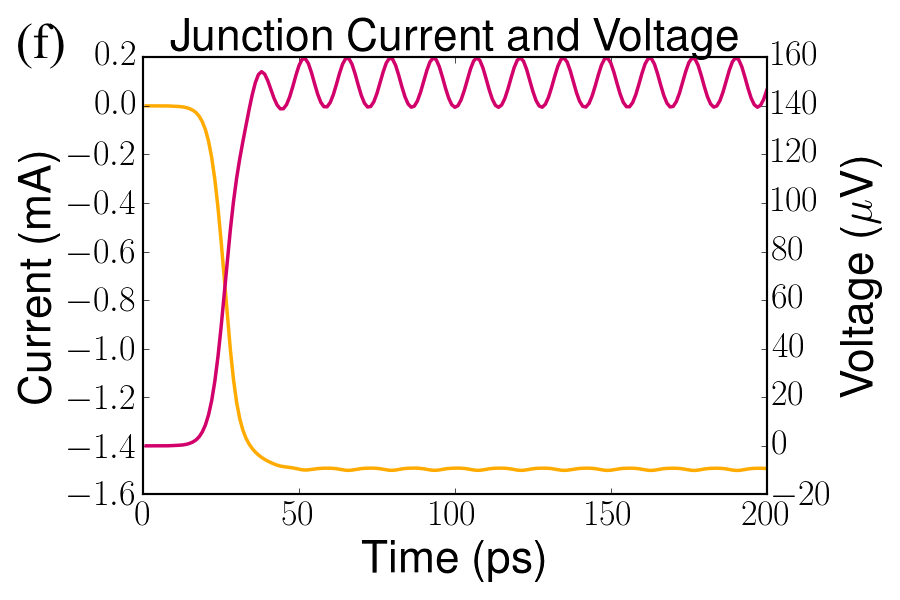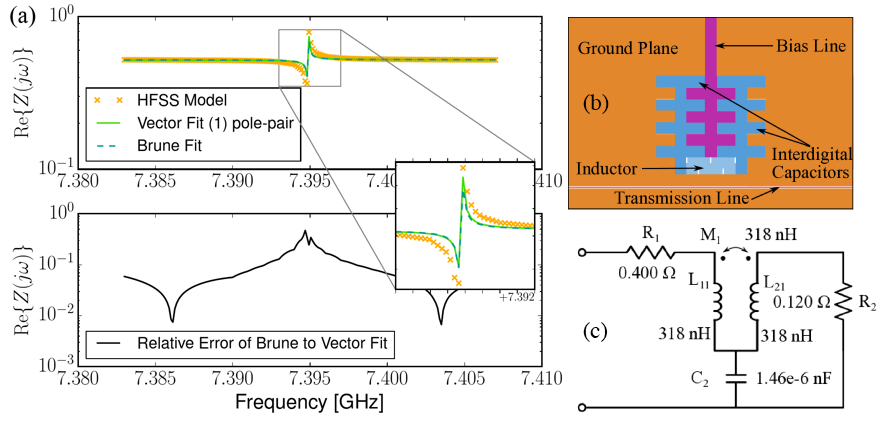Vincenzo Lordi (15-ERD-051)
Abstract
Quantum computers offer the potential to speed up exponentially certain types of computations by leveraging the inherently parallel nature of quantum bits (qubits). A promising scalable approach to implement the qubits uses superconducting circuits, but microscopic sources of noise related to materials used in their fabrication limit their performance. Understanding the sources of this noise and the ability to predict device performance for different designs and fabrication conditions are essential. The main objective of this project was to build an integrated modeling capability to predict the effects of noise realistically in qubit devices, by coupling atomistic descriptions of the origins of noise in materials to macroscopic device simulations. Density functional theory was used to compute the effects of various impurities and defect structures on the surfaces of materials that may lead to loss of fidelity of the quantum states. Magnetic interactions among hydroxyl and oxygen impurities on aluminum oxide were found to contribute magnetic flux noise. Oxidation of a novel superconducting material, magnesium diboride, was predicted to destroy the superconducting nature of its surface layer. An integrated modeling framework was implemented and tested, based on three-dimensional finite-element electromagnetic simulations that take input from microscopic noise models and feed into quantum dynamics equations. This work made a crucial step toward the ability to predictively simulate, design, and optimize superconducting circuit-based quantum devices. Future work could exercise this capability to study a broader array of materials and defects, and extend to more complex devices; opportunities exist for optimizing device designs as well as the control signals used to operate devices.
Background and Research Objectives
Proposed quantum computers will use the property of quantum bits (qubits) to be in a large number of states simultaneously to allow the computer effectively to perform a multitude of computations simultaneously, exponentially speeding up certain classes of difficult computational problems (Nielsen and Chuang 2000, Feynman 1982). Superconducting circuits are leading candidates for a scalable qubit architecture, because they leverage well-developed planar microfabrication technologies (Clarke and Wilhelm 2008, Martinis 2009). However, microscopic sources of noise associated with the surfaces of some materials used to fabricate specific superconducting qubits impractically limit their performance.
This project aimed to build an integrated modeling capability for the realistic treatment of noise (as a function of time and space) in engineered qubit systems by coupling atomic-scale models of materials-related noise sources to device-level circuit simulations. Such a capability will enable rational design of devices and fabrication processes to enhance performance (coherence) of superconducting qubits. The specific objectives included: (1) using atomistic simulations to identify magnetic defects associated with materials' surfaces and to predict their impacts on noise in superconducting qubit devices; (2) developing parameterized noise models describing the aforementioned noise origins; and (3) developing a geometric device modeling capability that incorporates such noise models as inputs.
The main results of the project included simulations of magnetic interactions associated with impurities on sapphire and silica surfaces, leading to magnetic flux noise models relevant for superconducting qubit devices (Lee et al. 2017, Adelstein et al. 2017, Ray et al. 2016a, 2016b, 2017a, 2017b). We computed the effects of surface structure and oxidation on disrupting the properties of a novel superconducting material magnesium-diboride (Kim et al.2017). We developed a formalism for a noise model associated with phonon coupling to so-called tunneling two-level systems (TTLS) that described a dielectric noise mechanism, as well as randomized noise models for dielectric and magnetic noise in device models. Finally, we implemented an integrated finite-element modeling capability for superconducting devices that incorporates noise models through quantum dynamics of equivalent circuits (Materise 2015, 2017a, 2017b, Materise et al. 2015, Lordi et al. 2015).
Scientific Approach and Accomplishments
Materials Sources of Noise and Models Thereof
Superconducting qubit decoherence is influenced by noisy microscopic degrees of freedom associated with materials, including magnetic degrees of freedom that produce flux noise (Bialczak et al. 2007), electric charge noise sources (Dial et al. 2013), and two-level systems (TLS) that cause dielectric loss in resonators (Pappas et al. 2011). A few prior works have attempted to use first principles microscopic calculations to predict noise parameters associated with materials defects (Lee et al. 2014; Holder et al. 2013; Gordon et al. 2014). In particular, our prior theoretical work showed that adsorbed hydroxyl groups on sapphire or alumina are likely sources of magnetic flux noise in superconducting loops (Lee et al. 2014). Recent experiments have suggested that adsorbed oxygen molecules also contribute to flux noise (Kumar et al. 2016). However, interactions among the noise degrees of freedom (impurities) are important (Faoro and Ioffe 2015), but have not been studied in detail previously.
A central aspect of integrated noise modeling in quantum systems is to take into consideration the materials' evolution and specific composition and structure. For instance, materials may degrade over time and surfaces will have different possible terminations, depending on growth conditions, preparation, and the experimental and storage environments.
To investigate long-range magnetic interactions among unpaired spins on relevant materials surfaces for superconducting qubits, we calculated the exchange interactions between hydroxyl groups adsorbed on the sapphire (0001) surface using density functional theory (DFT) and a large sapphire slab supercell with 684 atoms (Lee et al. 2017). The exchange interaction energy, which is a measure of the interaction strength and a critical parameter controlling flux noise, was computed as a function of separation, cluster geometry, and local strain. The results in Figures 1 and 2 show a strong exchange interaction up to 1.0 nm separation, which is mediated through the sapphire substrate and also depends sensitively on whether a surface oxygen vacancy is present between the hydroxyls or local (tensile) strain. Strain is also found to modulate the interaction from ferromagnetic to antiferromagnetic. The natural variations of exchange interaction due to local surface environments lead to spin dynamics that cause low-frequency noise in superconducting devices, as described later. The elucidation of these interaction degrees of freedom also present opportunities to possibly engineer surfaces for higher performing devices.
Figure 1. Ferromagnetic exchange energy computed between two separated spin-polarized hydroxyl groups on a sapphire surface. The red points include a surface oxygen vacancy between the two hydroxyl groups, showing a strong enhancement of exchange interaction.
We also investigated similar magnetic interactions due to oxygen molecules adsorbed on the surface, following recent experiments suggesting the presence of oxygen on alumina (Kumar et al. 2016). To characterize the interactions under different conditions, we performed DFT calculations for O2 molecules on both aluminum-terminated and fully hydroxylated sapphire surfaces. Oxygen molecules adsorb onto the aluminum-terminated sapphire (0001) surface in a hexagonal lattice of sites formed from surface aluminum atoms, where the molecules bind preferentially with an energy of about 310 meV, as shown in Figure 3a. Two possible binding sites with 16 meV difference in binding energy are shown in Figure 3b, which also indicates the two different symmetries of binding. Each symmetry is threefold degenerate over rotation by 120°, leading to 6 possible orientations of each adsorbed oxygen molecule, each with distinct magnetic moment. We also calculated the spin-spin exchange interaction between nearest neighbor molecules for all 15 symmetrically distinct pairs of relative orientations. A large variation of exchange interaction depending on relative orientation of nearest neighbors ranging from –2 meV to 4 meV was found, corresponding to both ferromagnetic and antiferromagnetic interactions. For the fully hydroxylated sapphire, similar results were obtained, except the exchange interactions between adsorbed oxygen molecules are uniformly antiferromagnetic in that case.
We used Monte Carlo simulation based on the adsorption energies determined from dispersion-corrected DFT to generate equilibrium distributions of bound oxygen molecules at 0.12 K on a 20x20 hexagonal lattice of binding sites. Then, cluster-update Monte Carlo was used to find equilibrium spin configurations of the ensemble, which tends to show small ferromagnetic clusters (Figure 3c). In an applied magnetic field, the spins mostly align, and we studied its temperature-dependence (Figure 3d), which showed a spin glass transition at 0.7 K (Ray et al. 2017a, 2017b), in reasonable agreement with measurements showing such a transition at 0.07 K (Sendelbach et al. 2008). The spin phase diagram was also computed using this approach.
To determine the frequency-dependent flux noise caused by these interacting spins, we implemented spin dynamics simulations based on the DFT-computed adsorption and interaction energies. These interactions were used to parametrize a Landau-Lifshitz-Gilbert dynamics equation to simulate the spin system dynamics explicitly in time, from which the noise spectral density is extracted via Fourier transformation. The frequency dependence of magnetic noise so determined comprises a noise model input for device models described below.
Beyond the sapphire or alumina surface, we also investigated the surface of silica, which is relevant for devices fabricated on silicon substrates. We found that a common native defect on this surface, related to a missing surface oxygen atom, can have a magnetic moment. However, this defect does not exhibit a low-energy magnetic fluctuation, so was predicted not to contribute to flux noise (Adelstein et al. 2017). The role of impurities on this surface was not evaluated and not ruled out as a potential noise source.
In addition to alternate surface terminations, superconducting materials may degrade during operation, depending on the environment. We examined the oxidization of the novel superconductor magnesium-diboride (MgB2) when exposed to an oxygen environment (e.g., ambient), a process which destroys the superconducting properties of the material's surface and therefore presents challenges to application of this material in quantum information devices. MgB2 is an interesting superconducting material since it has the highest known transition temperature (39 K) among conventional superconductors (Nagamutsa et al. 2001). We examined the effect of oxygen on the surface structure of both magnesium- and boron-terminated basal planes of MgB2, and the resultant electronic effects, using DFT (Kim et al. 2016, 2017). We found that the adsorption of oxygen on the boron-terminated surface causes a dramatic surface reconstruction, which can expose magnesium atoms from the subsequent layer to interaction with oxygen, promoting further oxidation. Importantly, the resulting reconstruction fundamentally disrupts the superconducting properties of the surface layers, potentially leading to strong loss mechanisms for devices fabricated with this material. Figure 4 shows the binding energies for oxygen adsorption on both B- and Mg-terminated surfaces of MgB2 and the associated large surface reconstruction (Kim et al. 2017).
Figure 4. Binding energy maps of oxygen atoms on B- and Mg-terminated (0001) surfaces of MgB2 and depictions of the surface configurations. B atoms in green, Mg atoms in orange, and O atoms in red.
Finally, in addition to magnetic noise, dielectric loss can lead to decoherence in superconducting circuits. As described by Faoro and Ioffe (Faoro and Ioffe 2015), an interacting model of two-level systems (TLS) in amorphous materials can reproduce the noise observed in high quality superconducting resonators, as well as the temperature dependence of TLS dephasing rates in qubits. The decoherence of the TLSs occurs through coupling to lattice phonons. We derived a formalism for calculating transition rates of TLS due to the emission of lattice phonons, as a noise mechanism. This formalism connects frozen phonon, nudged elastic band, and electric dipole calculations performed with DFT to compute TLS energy loss rates to a phonon bath. Given a specific material, the density of states of the phonon bath is also computed with DFT. This theoretical machinery enables the predictive calculation of dielectric loss tangent from microscopic defects. The loss tangent is a source of charge noise causing decoherence in devices and can be input to the device models described below.
Integrated Superconducting Qubit Device Modeling Capability
One of the main objectives of this project was to build an integrated modeling capability to predict the behavior of noisy superconducting qubit devices, based on 3D electromagnetic simulations coupled to materials noise models. We implemented such a modeling suite built primarily around the COMSOL Multiphysics software package (https://www.comsol.com) and incorporating both existing and custom software components. Various modes of incorporating materials noise models were implemented.
The first step involved generating a 3D model of the device of interest. Figure 5 shows an example model of a transmon-based 5-qubit device mimicking a design from UC Santa Barbara (Barends et al. 2014). We used this model and others to prototype capabilities for incorporation of noise models and extraction of the device quantum dynamics, as described in the following.
The basic device simulation output is the time-dependent electromagnetic response to applied control or test signals. Since the models fully describe the geometry and include materials layers or regions, a straightforward path to incorporating the materials noise models is through embedded fluctuations of materials parameters. For example, insulating layers are described by a dielectric constant, which is related to the charge response of the material; random fluctuations of the dielectric constant can be specified, following a known frequency dependence of the noise, which can derive from atomistic simulations or experiments. (When derived from atomistic simulations, this procedure amounts to a mean-field averaging, or "up-scaling," of the microscopic description to the macroscopic continuum.) Then, the device response, which feeds quantum dynamics simulations (described below), incorporates the materials noise source implicitly. Magnetic flux noise can be treated similarly, as well as any other material parameter such as loss tangent that enters the electromagnetic solution. An alternative approach is to parametrize a loss term in the quantum dynamics equations and bypass the device geometric model.
Typical planar superconducting qubit circuits, such as shown in Figure 5, use coplanar waveguide (CPW) transmission lines to transmit signals and more crucially act as resonator elements, where the intensity of the electric field is high relative to the total field in the device. These high electric field regions are especially susceptible to charge fluctuations, so an important parameter to assess a device design is the so-called "participation ratio," which measures the fraction of field intensity in a particular geometric region of interest (e.g., a specific material region, an interface, etc.). We implemented within our 3D finite-element device models (based on the COMSOL software) the capability to extract participation ratios for regions of interest, as demonstrated in Figure 6 for a complex CPW geometry including a substrate etch and detailed interface layers including metal-air, substrate-air, and metal-substrate interfaces. This type of analysis reveals the sensitivity to different physical noise sources for a specific geometric device design and enables geometric optimization for a set of known or hypothesized noise sources.
Josephson junctions (JJ) are superconducting circuit elements that are required to impose non-linearity necessary to create usable qubits. The non-linearity of the JJ current-voltage response arises from quantum effects, but a classical description can be formulated to allow embedding into a device model. We incorporated a damped, driven oscillator model of a JJ (Gross 2016) as a circuit element that can be inserted into our COMSOL models of superconducting qubits. The element is encoded as a current source that evolves like a resistor-inductor-capacitor (RLC) circuit whose resistance and inductance vary with the Josephson phase. We embedded this circuit model into the COMSOL software as a lumped port, modifying the classical electromagnetic fields computed by the Radio Frequency module. Figure 7 shows a schematic of the JJ implementation.
Our approach to treating the quantum dynamics of the superconducting circuit follows from prior work that used lumped-element circuit synthesis and quantization of the charge and flux equations of motion related to the extracted circuit. The method is based on a least-squares fit of the frequency-dependent impedance computed from the electromagnetic simulation of the device, as a pole-residue expansion, which is then converted to an arbitrarily precise hierarchical lumped-element circuit representation using the so-called Brune synthesis approach (Foster 1924, Brune 1931, Guillemin 1957). The Brune synthesis generates an equivalent circuit from the impedance function as a network of resistors, capacitors, inductors, and transformers in continued "stages," each similar to that shown in Figure 8b. The synthesized circuit then becomes the basis for constructing a quantum mechanical Hamiltonian describing the system dynamics, following (Burkhard et al. 2004, Burkhard 2005).
We developed a software toolkit integrating existing and custom codes to obtain the pole-residue expansion of the impedance parameters calculated by finite-element electromagnetic device simulation (Gustavsen and Semlyen 1999), extract the equivalent Brune circuit, and generate the quantum dynamics Hamiltonian. This toolkit comprises one of the main deliverables of this project (Materise 2017b). Figure 8 shows an example application of the full simulation pipeline to a qubit device consisting of interdigitated capacitors, a meander-line inductor, and Josephson junctions, coupled to a read-out transmission line.
Impact on Mission
This research project helped advance the state of the art toward realizing practical systems for quantum information, which has significant relevance for the cyber physical resilience mission research challenge at LLNL because of its powerful capabilities for national security applications such as encrypting or decrypting information. The work utilized and enhanced LLNL core competencies in advanced materials and manufacturing as well as high-performance computing, simulation, and data science, for which quantum computers may alsooffer a significant future computing platform. In addition, the results contribute to efforts in designing and building higher-sensitivity quantum sensors for various particles and radiation.
In addition, the project brought two new staff members to the Laboratory and served to recruit a possible future post-doc. Furthermore, this project supported a graduate student for two summer internships, providing recruitment for a likely future post-doctoral candidate.
Conclusion
We have established an integrated multiscale, multiphysics modeling framework for simulating the performance of superconducting quantum devices, taking into account the classical electromagnetic response of the three-dimensional device design, the atomistic nature of materials-related noise sources, and quantum dynamics that drive the behavior at low powers relevant for quantum information applications. We also successfully used predictive atomistic simulations to determine some relevant sources of qubit decoherence associated with common materials used in qubit fabrication, namely, magnetic impurities on sapphire or alumina, and also studied a novel material for possible future use (magnesium diboride). Nonetheless, this work is not comprehensive and represents a crucial starting point. The present work forms the basis for studying a broader array of materials, additional noise sources, and more complex device models. In addition, our results on spin interactions in the context of magnetic flux noise suggest a more generic principle that emergent correlated dynamics from many-body interactions at the microscopic level, as opposed to independent non-interacting actions, are characteristic of many noise sources. Further work on these complex mesoscale effects at the material level is warranted to accurately bridge the gap from atomistic to circuit-level models. Furthermore, our work studying the degradation paths of MgB2 could be a paradigm for continued exploration of the evolution of materials properties over time using first-principles simulations that should remain an important topic of consideration when designing and fabricating qubit devices.
At the device level, extension of the present work to a multiport circuit synthesis and quantization implementation would be valuable. Compared to the single-port methodology currently implemented, a multiport version could treat more complex geometries and possibly enable the separate treatment of various segments of a complex device model independently, for improved computational efficiency. Detailed integrated device simulations incorporating experimental pulse sequences in the presence of realistic noise could be used to both optimize pulses and also design experiments to study the details of materials and noise sources, in addition to informing device design optimizations.
References
Adelstein, N., et al. 2017. "Magnetic Stability of Oxygen Defects on the SiO2 Surface." AIP Advances 7:025110. doi: 10.1063/1.4977194. LLNL-JRNL-645056.
Barends, R., et al. 2014. "Superconducting Quantum Circuits at the Surface Code Threshold for Fault Tolerance." Nature 508:500–>503.
Bialczak, R. C., et al. 2007. "1/f Flux Noise in Josephson Phase Qubits." Physical Review Letters 99:187006.
Brune, O. 1931. "Synthesis of a Finite Two-Terminal Network Whose Driving Point Impedance Is a Prescribed Function of Frequency." Ph. D. thesis, Massachusetts Institute of Technology.
Burkard, G. 2005. "Circuit Theory for Decoherence in Superconducting Charge Qubits." Physical Review B 71:144511.
Burkard, G., et al. 2004. "Multilevel Quantum Description of Decoherence in Superconducting Qubits." Physical Review B 69:064503.
Clarke, J. and F. K. Wilhelm. 2008. "Superconducting Quantum Bits." Nature 253:1031–1042.
Dial, O. E., et al. 2013. "Charge Noise Spectroscopy Using Coherent Exchange Oscillations in a Singlet-Triplet Qubit." Physical Review Letters 110:146804.
Faoro, L. and L. B. Ioffe. 2015. "Interacting Tunneling Model for Two-Level Systems in Amorphous Materials and Its Predictions for Their Dephasing and Noise in Superconducting Microresonators." Physical Review B 91:014201.
Feynman, R. P. 1982. "Simulating Physics with Computers." International Journal of Theoretical Physics 21:467–488.
Foster, R. 1924. "A reactance theorem." The Bell System Technical Journal 3:259–267.
Gilbert, T. L. 2004. "A Phenomenological Theory of Damping in Ferromagnetic Materials." IEEE Transactions on Magnetics 40:3443–3449.
Gordon, L., et al., 2014. "Hydrogen Bonds in Al2O3 as Dissipative Two-Level Systems in Superconducting Qubit." Scientific Reports 4:7590.
Gross, R., et al. 2016. Applied Superconductivity: Josephson Effect and Superconducting Electronics, Chapter 3. Berlin: Walter De Gruyter.
Guillemin, E.A. 1957. Synthesis of Passive Networks. New York: John Wiley & Sons, Inc.
Gustavsen, B. and A. Semlyen. 1999. "Rational Approximation of Frequency Domain Responses by Vector Fitting." IEEE Transactions on Power Delivery 14:1052–1061.
Holder, A. M., et al., 2013. "Bulk and Surface Tunneling Hydrogen Defects in Alumina." Physical Review Letters 111:065901.
Kim, C. E., et al. 2016. "Electronic Structure and Surface Property of MgB2: Adsorption on Low Index Facets." LLNL Summer Student Poster Symposium, Livermore, CA, 2 August 2016. LLNL-POST-830325.
——— 2017. "Electronic Structure and Surface Properties of MgB2: Oxygen Adsorption on MgB2(0001)." Manuscript.
Kumar, P., et al. 2016. "Origin and Reduction of 1/f Magnetic Flux Noise in Superconducting Devices." Physical Review Applied 6:041001.
Lee, D., et al. 2014. "Identification of the Local Sources of Paramagnetic Noise in Superconducting Qubit Devices Fabricated on alpha-Al2O3 Substrates Using Density-Functional Calculations." Physical Review Letters 112:017001.
——— 2017. "Exchange Interactions of Paramagnetic Spins on Alpha-Al2O3 Substrates from Density-Functional Theory Calculations." Manuscript in preparation.
Lordi, V. et al. 2015. "Materials-Related Noise in Superconducting Qubits: Physics-Based Noise Modeling from Materials to Devices." IBM ThinkQ Workshop, Yorktown Heights, NY, 2–4 December 2015. LLNL-POST-657112.
Martinis, J. M. 2009. "Superconducting Phase Qubits." Quantum Information Processing. 8:81–103.
Materise, N. 2015. "Simulation of Superconducting Qubit Devices Using COMSOL." Workshop on Microwave Cavity Design for Axion Detection, Livermore, CA, 25–27 August 2015 (invited). LLNL-ABS-676280, LLNL-PRES-676622.
——— 2017a. "Simulation of Superconducting Qubit Devices." 2nd Workshop on Axion Cavity Development, Livermore, CA, 10>–13 January 2017 (invited). LLNL-ABS-717285, LLNL-PRES-717283.
——— 2017b. "Brune Circuit Synthesis and Quantization." LLNL-TR-732173.
Materise, N., et al. 2015. "Simulating Noisy Superconducting Qubits." IBM ThinkQ Workshop, Yorktown Heights, NY, 2–4 December 2015. LLNL-POST-679779.
Nagamatsu, J., et al. 2001. "Superconductivity at 39 K in Magnesium Diboride." Nature 410:63–64.
Nielsen, M. A. and I. L. Chuang. 2000. Quantum Computation and Quantum Information. Cambridge: Cambridge University Press.
Pappas, D. P., et al. 2011. "Two Level System Loss in Superconducting Microwave Resonators." IEEE Transactions on Applied Superconductivity 21(3):871–874.
Ray, K. G., et al. 2016a. "Paramagnetic Spins on Al2O3 with Varied Surface Termination." American Physical Society March Meeting, Baltimore, MD, 14–18 March 2016. LLNL-PRES-686344, LLNL-ABS-740884.
——— 2016b. "Paramagnetic Spin Dynamics on Sapphire with Realistic Surface Termination." Materials Research Society Fall Meeting, Boston, MA, 27 November – 2 December 2016. LLNL-PRES-713001, LLNL-ABS-694926.
——— 2017a, "Paramagnetic Spin Dynamics on Different Terminations of Al2O3." American Physical Society March Meeting, New Orleans, LA, 13–17 March 2017. LLNL-PRES-727106, LLNL-ABS-708971.
——— 2017b. "Spin Dynamics of Oxygen Molecules as Flux Noise Sources in Superconducting Qubits." Manuscript.
Sendelbach, S., et al. 2008. "Magnetism in SQUIDs at Millikelvin Temperatures." Physical Review Letters 100:227006.
Publications and Presentations
Adelstein, N., et al. 2017. "Magnetic Stability of Oxygen Defects on the SiO2 Surface." AIP Advances 7:025110. doi: 10.1063/1.4977194. LLNL-JRNL-645056.
Kim, C. E., et al. 2016. "Electronic Structure and Surface Property of MgB2: Adsorption on Low Index Facets." LLNL Summer Student Poster Symposium, Livermore, CA, 2 August 2016. LLNL-POST-830325.
——— 2017a. "Electronic Structure and Surface Properties of MgB2: Oxygen Adsorption on MgB2(0001).>" Manuscript.
——— 2017b. "Quest for Reliable Quantum Computing: Microstructural Origin of Decoherence Noise." LLNL Summer Student Poster Symposium, Livermore, CA, 2 August 2017. LLNL-POST-735250.
Lordi, V. 2015. "Discovering and Controlling the Materials Origins of Noise in Qubits." Beyond Exascale: Qubits for Quantum Computing Workshop, Oak Ridge, TN, 20–21 August 2015 (invited). LLNL-PRES-663398.
Lordi, V. et al. 2015. "Materials-Related Noise in Superconducting Qubits: Physics-Based Noise Modeling from Materials to Devices." IBM ThinkQ Workshop, Yorktown Heights, NY, 2–4 December 2015. LLNL-POST-657112.
Materise, N. 2015. "Simulation of Superconducting Qubit Devices Using COMSOL." Workshop on Microwave Cavity Design for Axion Detection, Livermore, CA, 25–27 August 2015 (invited). LLNL-ABS-676280, LLNL-PRES-676622.
——— 2017a. "Simulation of Superconducting Qubit Devices." 2nd Workshop on Axion Cavity Development, Livermore, CA, 10–13 January 2017 (invited). LLNL-ABS-717285, LLNL-PRES-717283.
——— 2017b. "Brune Circuit Synthesis and Quantization." LLNL-TR-732173.
Materise, N., et al. 2015. "Simulating Noisy Superconducting Qubits." IBM ThinkQ Workshop, Yorktown Heights, NY, 2–4 December 2015. LLNL-POST-679779.
Ray, K. G., et al. 2016a. "Paramagnetic Spins on Al2O3 with Varied Surface Termination." American Physical Society March Meeting, Baltimore, MD, 14–18 March 2016. LLNL-PRES-686344, LLNL-ABS-740884.
——— 2016b. "Paramagnetic Spin Dynamics on Sapphire with Realistic Surface Termination." Materials Research Society Fall Meeting, Boston, MA, 27 November – 2 December 2016. LLNL-PRES-713001, LLNL-ABS-694926.
——— 2017a. "Paramagnetic Spin Dynamics on Different Terminations of Al2O3." American Physical Society March Meeting, New Orleans, LA, 13–17 March 2017. LLNL-PRES-727106, LLNL-ABS-708971.
   


